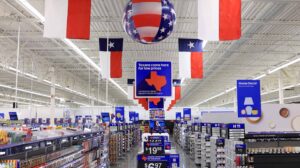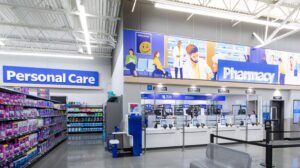[Editor’s note: Walmart’s decision to expand its Store of the Future concept in 2025 has been a hot topic for consumers and Walmart suppliers alike. Mark Stallcup, VP of Supply Chain and Replenishment at 8th & Walton took some time to answer pertinent questions about Walmart’s decision to remodel so many stores. –L.P.]
Lainie: Walmart has announced that it is expanding its store of the future concept by opening new locations and remodeling 650 existing stores. Why do you think Walmart is making this move right now?
Mark: Project stores happen on an ongoing basis. There’s a budget window for stores after they’ve been open for five, 10, or 15 years to reinvest in the company’s capital and assets. That’s putting a lot of money in a lot of stores, but Walmart is doing it not just to refresh the old look, but to enable those boxes to be productive in what we now call the omni-world.
A lot of the 650 seems to be aiming its throughput in the box that is shifting perhaps from staffed registers to some self-checkouts, as they’ve been doing, but even more so to improve the flow-through of the pickers. So, right-line pickup and delivery can really enable that.
Lainie: How will this affect inventory management, placement, and supply chain requirements for suppliers?
Mark: In conjunction with this announcement, we’ve received additional information about the accountability suppliers will have for reducing nil picks and keeping them at a very low level. A nil pick would be when the order filler for pickup or delivery does not find the item in the location. So that’s going to be a point of focus for the supplier community.
Need Help Navigating These Changes?
As Walmart expands its Store of the Future initiative, suppliers will face new requirements and greater pressure to perform. Whether it’s understanding nil picks, staying compliant with packaging standards, or adapting to store remodels, our experts are here to help. Fill out the form below to connect with our team and schedule a free consultation.
Lainie: There will also be some expanded departments, new displays, and similar additions. What opportunities and challenges do suppliers face, especially regarding shelf space allocation?
Mark: It’s a great question because all points of distribution or side counter locations pop in and pop out over time. That’s not even part of a regular annual modular. And that’s the outcome of these projects throughout the year, across all these stores. It’s not negotiated and not really driven by particular supplier attributes or opportunities; it’s more of an outcome that happens by allocating more footage to a category. From that point, they do modular drawings for these 650 stores, and will have those categories redrawn, where they’ve either added or taken footage away from them.

Lainie: Technology advancements are accelerating rapidly, and Walmart is keeping pace. What are suppliers going to have to do to support Walmart’s technological requirements, such as adapting packaging or products to make Walmart’s omnichannel dream happen?
Mark: The supply chain requirements are well-stated, and they’re updated every six months as to what packaging needs to look like. And that’s what we’re talking about because it makes it all the way to the shelf. That shipping carton actually shows up on the shelf. So those requirements that have changed are more about automated warehouse receiving and order filling, than necessarily at the store. But I believe the pick issue could be a part of that. It could be product uniqueness. The ability for a picker to identify products uniquely at the shelf is going to improve the nil pick issue.
Lainie: When you say, “identify the product uniquely at the shelf,” what would the distinction be? What would make that product or packaging unique so that the picker can easily do that?
Mark: Color, size, images. . . the UPC scan. The amount of distinction that can be put on a product will be minimal, as it shouldn’t degrade the point-of-sale attractiveness to the consumer. So, it’s a balance, and it’ll be very interesting to watch how we manage those nil picks as they become a bigger part of the sale.
I’m hoping for wider aisles in some of the heavily picked areas. We think about grocery being, full of blue carts most of the time, and I’m hoping for some allocation of footage for that to be more efficient. Probably it’ll have to do with register count, the drive- up spaces and a lot of front-line technology.

Lainie: Walmart is making some changes in the pharmacy areas, improving privacy and the opportunity for private consultations. Should suppliers consider that Walmart might be looking to expand in pharmacy and over-the-counter medications?
Mark: Yes. In fact, Walmart presented some of the growth plans to the public a couple of months ago regarding pharmacy service.
We’ve already seen vaccinations and privacy rooms remodeled into pharmacy areas so that pharmacists and customers can have consultations. Many states are modifying laws regarding what pharmacists can do in relation to customers purchasing prescriptions, such as automated refills. Pharmacies have quite a bit of investment in technology to attract some of us older shoppers who don’t as often leverage technology, but often have a significant need for those Rx items.
I think that Walmart’s bringing us into a user-friendly, logical, intuitive interface for pharmacy services is a wise move.
8th & Walton is based in Bentonville, Arkansas: Walmart is our neighbor! Contact us today by filling out the form below to set up a free consultation and see what a hometown advantage can do for your company.

